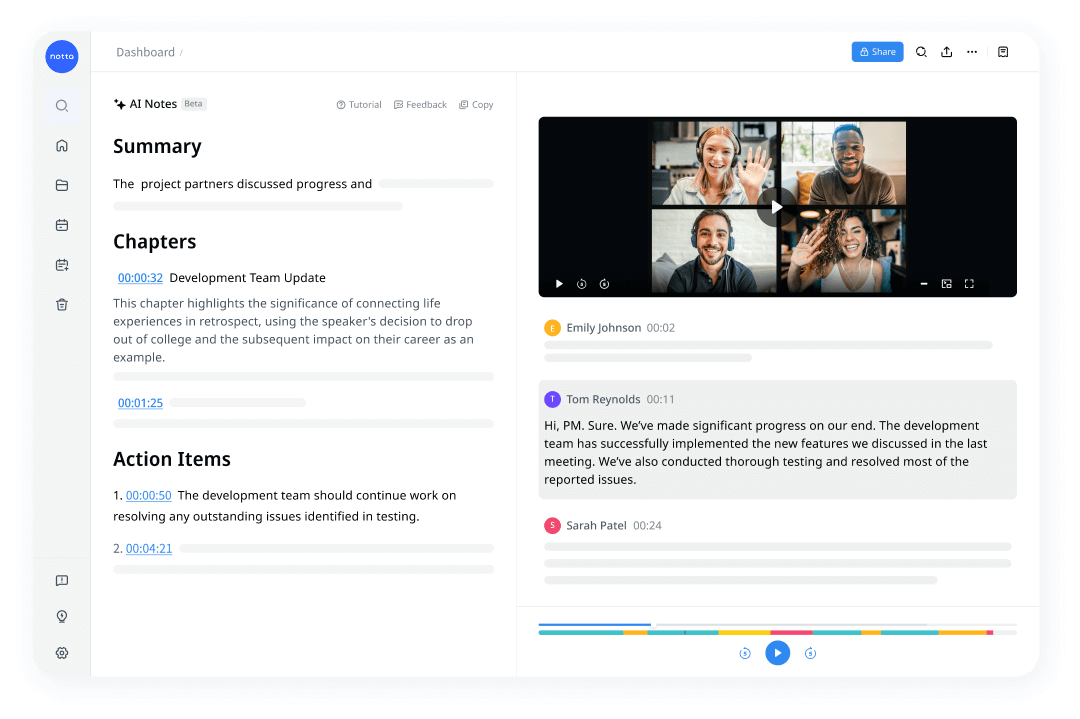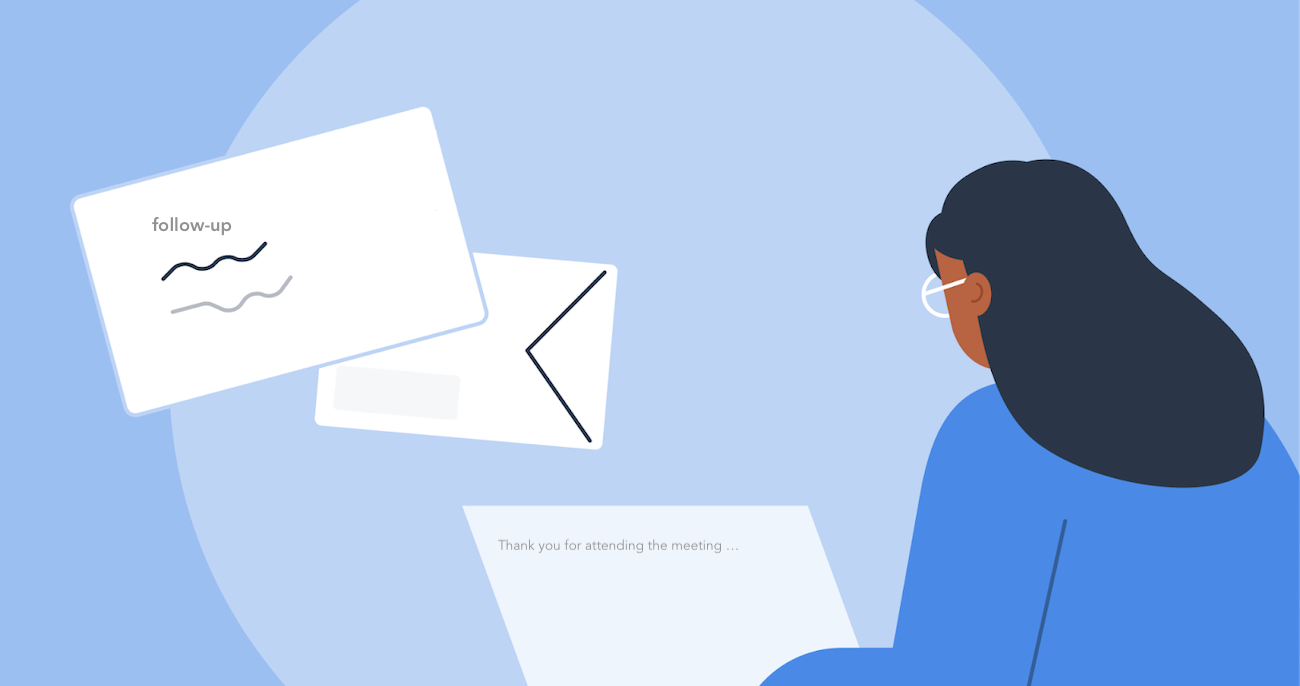Do you have a sigh of relief after a meeting with a prospect and close your laptop? Hold on, there is one more thing to do to call the meeting a success — send a follow-up message.
An email follow-up after a meeting is often overlooked, even though it plays a crucial role. Apart from leaving a good impression, following up after a meeting is a great way to ensure that all the important points are covered and to clarify any remaining questions or concerns.
This is not a tough task, but it requires a bit of careful planning.
That’s why we created this guide: to guide you to write an effective post-meeting email, loaded with insider tips and templates to get started.
What is and when to send a follow-up email?
A meeting follow-up email is a message that you send to attendees after a meeting to summarize what was discussed and review any action items or decisions made.
The purpose of the email is to express gratitude to the participants, ensure everyone is on the same page, and offer a chance to clarify any concerns.
Although meeting follow-up doesn’t always have to be in an email (it can also be shared via Slack), it is a widely accepted way, especially for formal business meetings.
When to follow up after a meeting?
When it comes to sending a business email, timing is an important factor to consider.
Typically, a follow-up thank you email should be sent within 24 hours of the meeting when the words remain fresh in the recipient’s mind. But there are situations qualified for a longer interval.
Within 48 hours: In case an application should be submitted or there were no action items assigned during the meeting.
Within 1-2 weeks: If there is no response regarding a job interview or request.
Every three months: If you only intend to keep in touch with a network member.
How to craft a meeting follow-up email?
The elements of the follow-up email may vary based on the meeting types, but they generally include the following:
A show of appreciation
A mention of your discussion with the recipient to provide context
Key takeaways from the meeting
Next steps
An invitation for questions on any matter that requires clarification
Scheduling the next meeting (optional)
Now, let’s get our hands on crafting a follow-up letter after the meeting.
1. Write a compelling subject Line
47% of email recipients glance at the subject line to determine whether to open an email or not. Therefore, if you want your recipients to read your follow-up letters after the meeting, create a subject line that quickly makes it clear what the email is about. A good way to do this is to use a subject line that’s relevant to the meeting topic.
For example, if you had a meeting about your company’s content strategy, the subject line could be “Content Strategy Meeting Follow Up.”
Some follow-up email subject lines to use:
2. Show appreciation
Time is a precious commodity in the workplace. As such, while writing a follow-up email after the meeting, it’s a kind gesture to appreciate the participants for taking the time to attend the meeting and for their contributions to the discussion, even if you have already thanked them in person during the meeting.
3. Refresh their memory (of the meeting)
If this is your first time meeting with a client, start the message by giving a short self-introduction (your name, position, and company) and a mention of the discussion you just had. This will spare them extra time trying to figure out who you are and why you are sending this email.
Also, write a sentence about what you enjoyed about the meeting to establish a common ground and make the email intriguing.
4. Give a brief summary of the meeting

For business meetings, the body of your follow-up email should provide a quick recap of the meeting. Even if the attendees took their own meeting notes, omission or misunderstanding happens, so it’s always good to confirm everyone is on the same page with a meeting summary.
Here is the information you should cover:
If there are unanswered questions or uncertainties about issues, clarification can also be provided in the email follow-up.
5. Highlight the next steps
To ensure that there are no uncertainties about what needs to be done, highlight the next steps from the meeting with the responsible person and the timeline. Also, include a call to action to get the ball rolling immediately.
This ensures that everyone knows their responsibilities and holds them accountable by having these responsibilities in writing.
Tip: Find it time-consuming to extract action items from lengthy conversations or worry that you may miss some? Notta is here to help. It can not only record your meeting and create a transcript automatically but also generate a meeting summary with action items listed, saving you much time in writing a follow-up email.
6. Include the next meeting time (optional)
Only include this point if you are meeting someone regularly. A quick reminder of the next scheduled meeting at the end of a post-meeting email will give the recipient a heads-up quickly.
Run effective team meetings with Notta
Notta AI meeting assistant records, transcribes, and summarizes meetings so everyone can stay engaged without missing important details.
Pro tips for writing an effective follow-up email
Now you know what to include and how to write a follow-up thank you email after the meeting, below are some tips that will make you a pro.
1. Have a clear objective
Don’t just write a meeting follow-up email for the sake of it. You need to have a clear objective that you want the email to achieve.
This could be something like providing information about the steps you want the recipient to take, offering your help with something, or providing more information about what was discussed in the meeting.
2. Personalize your message
Even if you use a follow-up email template, don’t use the same generic email after every meeting. This will come off as insincere.
What you should do instead is personalize the email by mentioning the recipient’s name, highlighting something about the meeting that stood out to you, or even mentioning something about the recipient that came up during the meeting.
For example, if the recipient mentioned that their favorite team was playing that night, you could mention the results of the game in the follow-up email the next day.
3. Keep it short and sweet
When it comes to follow-up emails, less is more. People already took time off their busy days to attend a meeting with you. You don’t want them to waste more time going after the same things that were said in the meeting. Therefore, avoid any unnecessary details and go straight to the point.
4. Provide value
If you want to make an impression in your recipients’ minds, don’t just go over what was covered in the meeting. Instead, use the follow-up email as an opportunity to provide more value. You can do this by providing additional information and resources that will help the recipient achieve their goals.
For example, if the recipient mentioned that they are struggling with driving more traffic to their website, you can send them a link to an insightful article or video on how to increase site traffic.
6 follow-up email templates after meeting
It’s time to practice. Let’s go over some effective email follow-up templates that apply to different use cases and help you better grasp the essence of writing a post-meeting email.
1. Follow-up after a conference or networking event
If you had a great time communicating with someone at a conference or event and promised to share some valuable information, make sure to send a follow-up email and remind them who you are.
Dear [Name],
It was wonderful meeting you at [event] on [date]. I remember you mentioning that [special topic discussed].
Following up, I have checked [what you do]. Here is a document that will help: [link].
If you’re interested to learn more, I’m also happy to plan a time to meet for further discussion.
Again, it was a pleasure meeting you. Let’s keep in touch!
Best regards,
[Your Name]
2. Follow-up after a project or team meeting
Hi [team],
Thank you for making time to attend the [project or team meeting] yesterday. I appreciate everyone's input and participation in the discussion.
To ensure we are all on the same page, I have summarized our key takeaways and next steps:
We’ll have the next meeting on [date] to review our progress.
Once again, I am really grateful for your valuable contributions to the meeting. If anyone has any additional thoughts or questions, please don't hesitate to reach out to me directly.
Sincerely,
[Signature]
3. Follow-up email after meeting with client/prospect
Dear [Name],
Thank you for taking the time to meet with me and learn more about our [product/service]. I was impressed to learn that [client achievements].
As you’re intending to [the client’s aim for using your service], ]I believe our [product/service] can help. I’d like to share the story of a client similar to yours who [the results of using your service]: [link].
Please let me know if you are interested in moving forward with a proposal or if you need more information.
I would appreciate the opportunity to answer any additional questions and discuss the next steps in more detail.
Best regards,
[Your Name]
4. Follow-up email after a business meeting
Dear [Name of Attendee],
I hope this email finds you well. I just wanted to take a moment to thank you for taking the time to meet with me [or our team] earlier today. It was great to have the opportunity to discuss [topic of discussion] with you and to learn more about your thoughts on [related topic].
As a reminder, we agreed to
I want to make sure we stay on track and meet these deadlines, so please let me know if there are any issues or concerns that may arise.
Additionally, I wanted to provide you with some additional resources that may be helpful: [link]
We appreciate your patience and time.
Best regards,
[Signature]
5. Follow-up after an informative meeting/training
Dear [Name],
Thank you for attending [meeting or training session] yesterday. I hope you found the sessions informative and valuable.
As discussed, I have attached a copy of the presentation I gave on [topic]. Please let me know if you have any additional questions or if there are any other resources I can share with you.
Thank you again for your participation.
Best regards,
[Your Name]
6. Follow-up email after a job interview
Dear [Name],
Thank you for considering me for the [position] role at [company]. I appreciate the time you took to talk with me about the opportunity and learn more about the company culture.
I am excited about the possibility of joining your team and contributing to your [specific goal or project]. Please let me know if there are any additional materials or references I can provide to assist in your decision-making process.
Thank you again for your consideration, and I look forward to hearing from you.
Best regards,
[Your Name]
Wrapping up
Sending a follow-up email after a meeting is an easy task, yet it makes a big difference. It can go a long way in building strong relationships and achieving successful outcomes.
With the best practices and templates listed in this post, you will surely craft a perfect meeting follow-up email with the essential components covered:
Moreover, you can use the Notta meeting productivity tool to record, transcribe, and summarize meetings to make your follow-up easier!

